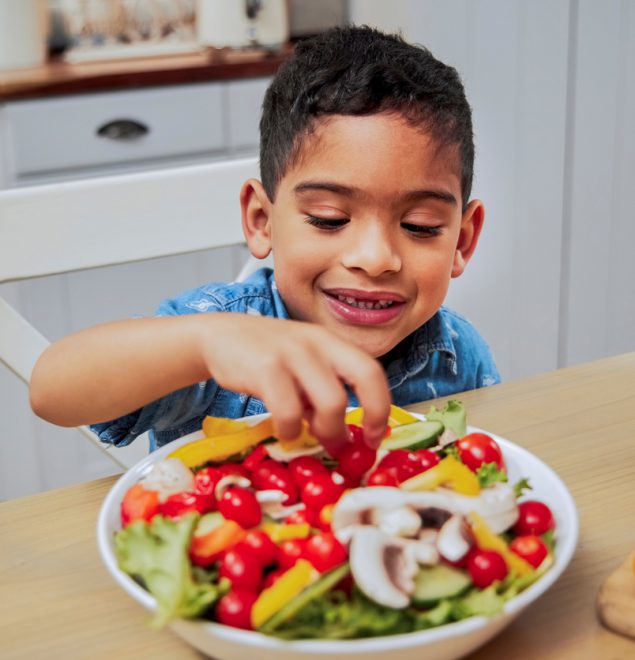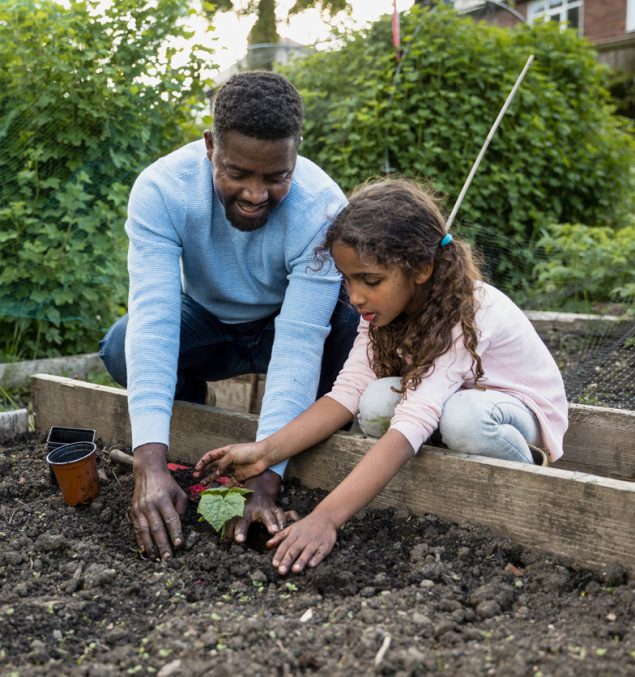Give Your Kids a Healthy Body and Mind This Summer

Learn ways you can support your child’s physical and emotional well-being.

Playing outdoor games can keeps kids physically active.
Helping our children have healthy bodies and minds is more important than ever. Parents can support their children’s physical and emotional well-being by providing them opportunities to:
- Handle stress well through physical activity and healthy thinking
- Relate to others by encouraging social interactions and emotional awareness
- Make healthy choices with how they eat and play
Here are some ways you can promote your child’s healthy body and mind through physical activity, good nutrition, and skills for emotional well-being.
Physical Activity
Here are activities your child can do indoors and outdoors.
Goals:
- Get 60 minutes of physical activity each day
- Get outside when possible
- Try new activities
Ideas for indoor activities:
- Play games that encourage movement. Are the kids stuck in the house on a rainy day? Check out this list of fun games and this printout to help your kids get physical activity when they can’t go outside.
- Watch this video for tips to help your kids get moving when you need to stay active indoors.
- Learn a fun dance move or try a new sport. Trying something new can be fun and rewarding.
- Challenge yourself the Presidential way. Think your kids can take on the Presidential Youth Fitness Program and win? See if they can complete all the goals on this page.
Ideas for outdoor activities:
Safety Considerations
Why Physical Activity Is Important:
Addressing Physical Activity in Schools:
- Plan exercise around your day. Are your kids going to a camp or activity? Use these ideas to plan out and add physical activity before, during, and after those events.
- Discover a fun new activity. Try a new activity or learn a new sport with friends – it can be rewarding and fun!
- Explore nature. Use this Family Nature Club Toolkit to help you plan and share outdoor experiences with like-minded friends and families who are yearning for “more green, less screen.”

Adding a fruit and more vegetables can make salads fun to eat.
Nutrition
Here are several ways to learn more about nutrition and options for families to try something new.
Learn More About Nutrition:
- An app for kids that teaches smart food choices. Download the Dining Decisions mobile app on your phone or tablet to help your kids learn about healthy food choices at home or on the go.
- Games and activities that promote healthy eating. Find a list of interactive websites and activities for kids that are appropriate for different grade levels.
- Foods for your family. Learn about GO, SLOW, and WHOA foods to help you plan your grocery shopping trips. Learn healthy eating tips to add healthy fats, cut sodium, bump up fiber, and aim for a variety of colors on your plate.
- Benefits of drinking water. Find out why it’s important to choose water and healthier drinks.
Goals:
- Include fruits and vegetables with each meal
- Eat less sugar
- Practice making healthy food choices as a family
Try Something New:
- Make a new recipe with your child. Choose a kid-friendly recipe that includes a fruit or veggie your child likes. It’s a great way to bond and encourage cooking habits in the home.
- Try a new fruit or vegetable. Use a list of fruits and vegetables and ask your child to pick some to try. Give your child a chance to “rate” the fruit or vegetable using this Kids Food Critic activity to make exploring new foods more exciting.
- Try new healthy snacks. Use this list of healthy snacks to come up with your own list of snacks for your family to try.
Safety Considerations
How to be safe when preparing and eating food:
Why Healthy Eating Is Important
Addressing Nutrition in Schools
- Choose water over sugary drinks. Discover tricks to rethink your drink.
- Provide a variety of healthy foods for breakfast. A healthy breakfast can include foods that aren’t traditional breakfast foods. Here are some quick and easy tips for making healthy breakfasts for kids.
Emotional Well-being
Here are things your child can do to enhance emotional well-being no matter if they are spending time alone or with others.

Gardening together can foster encouragement, teamwork, and improve mood.
Alone:
- Give your child a new responsibility that fits their age. Learn how steps you can take to help your child recognize and manage emotions, set and achieve positive goals, and make responsible decisions.
- Nurture your child’s creativity and self-esteem through arts and crafts. See this guide for 15 art lessons you can use in the home to support your child socially and emotionally.
- Grow plants in a container. Use this activity for teaching your child how to set a goal and achieve it. Here you can find tips for making a terrarium mini-garden.
- Help your child get enough sleep. Check out this infographic on the right amount of sleep for children, the importance of sleep, and tips for good sleep.
- Reduce time watching a screen. Learn how parents can help their child get less screen time and more “lean” time doing physical activity.
- Teach your child ways to think positively, like being grateful, to help reduce stress and feel better. Discover ways to practice gratitude.
Goals:
- Get plenty of sleep each day
- Practice positive thinking
- Include others in activities
- Reduce screen time
With Others:
- Show kids that they belong. Learning to hear your own voice and honor the voice of others is a great way to build positive friendships. Check out these videos by kids that show how this happens at school and home.
- Learn how others move and think. Dancing to music from other countries and languages can strengthen the ability to empathize with others from diverse backgrounds and cultures. Try dancing, for example, to hits from around the world or other multicultural music options.
Safety Considerations
- Getting Adequate Sleep
- Managing Stress Well
- Helping Kids to Cope in Daily Life and in Emergencies.
- Dealing With Trauma And Loss
- Addressing Bullying
- Thoughts of Suicide
Why Emotional Well-Being and Mental Health Are Important
Addressing Emotional Well-Being in Schools
- Help out others and grow relationships. Try planting a garden or volunteering at a community garden as a family. This can help foster teamwork and strengthen relationships.
- Raise stronger kids through positive parenting. Kids are empowered when they feel understood and trusted. Try using these positive parenting tips to help strengthen their self-confidence and resilience.
- Get active in your community. Camps and other out of school time programs provide opportunities for children to try new activities, develop relationship and social skills, and be physically active. Visit your county’s parks and recreation website or stop by a local center for information on free summer sessions near you.
References
- Jones SE, Ethier KA, Hertz M, et al. Mental health, suicidality, and connectedness among high school students during the COVID-19 pandemic – Adolescent Behaviors and Experiences Survey, United States, January-June 2021. MMWR Suppl. 2022;71(3):16-21. doi:10.15585/mmwr.su7103a3
